Sensor Sweep: Robert E. Howard, Manly Wade Wellman, Ravenloft, Flight of the Amazon Queen
Monday , 31, May 2021 Sensor Sweep 1 CommentCinema (Skillset): For most people, there is likely one film that in their minds defines a generation of hardcore, action moviegoers with its scenes and quotes. For the Generation X crowd (those born from 1965 through 1980), Red Dawn was that defining movie. It opened at the box office in August of 1984 during the height of the Cold War and midway through Ronald Reagan’s presidency, and the film certainly got a lot of media attention and was even anti-Russian enough to be denounced by then-Soviet deputy cultural minister Georgi Ivanov.
minds defines a generation of hardcore, action moviegoers with its scenes and quotes. For the Generation X crowd (those born from 1965 through 1980), Red Dawn was that defining movie. It opened at the box office in August of 1984 during the height of the Cold War and midway through Ronald Reagan’s presidency, and the film certainly got a lot of media attention and was even anti-Russian enough to be denounced by then-Soviet deputy cultural minister Georgi Ivanov.
Robert E. Howard (Intercollegiate Studies Institute): Robert E. Howard possessed a strong streak of nihilism. When Lovecraft confronted him about his view of humanity, he replied misanthropically, “To my mind the human race is merely a parasitic freak of two legged fungi that pollutes the universe, which would be better off—and much cleaner—without it. I have a strong prejudice in favor of life, but from a philosophic standpoint, honestly believe the universe would be better off without human varmints of any kind.” History had no real meaning for Howard.
Author Interview (DMR Books): Then, and I could not believe it, came a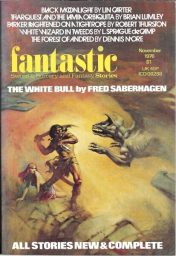 letter from Ted White accepting “Fugitives in Winter” for Fantastic Stories. 1974, that was. The magazine was strapped for cash and could only pay on publication, not on acceptance, which Ted explained was not how he liked to do things but the way he had to do them since Fantastic’s national print order had just been drastically cut.
letter from Ted White accepting “Fugitives in Winter” for Fantastic Stories. 1974, that was. The magazine was strapped for cash and could only pay on publication, not on acceptance, which Ted explained was not how he liked to do things but the way he had to do them since Fantastic’s national print order had just been drastically cut.
Comics (Arkhaven Comics): However, she has her fans. So they were all excited when they heard that Heavy Metal was bringing her back. I don’t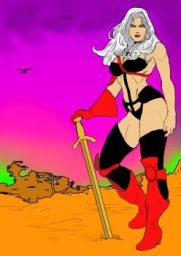 know why the hell they were excited because Stephanie Phillips was going to be writing her. Phillips was hired by DC Comics in the last five years which should tell you everything you need to know about her. Taarna the Tarakian has never worn more than her armored bikini and usually wears a lot less than that. As naturally as a pterodactyl-chicken gets shot down by a barbarian-zombie, Taarna was provided with full-body modest-ware.
know why the hell they were excited because Stephanie Phillips was going to be writing her. Phillips was hired by DC Comics in the last five years which should tell you everything you need to know about her. Taarna the Tarakian has never worn more than her armored bikini and usually wears a lot less than that. As naturally as a pterodactyl-chicken gets shot down by a barbarian-zombie, Taarna was provided with full-body modest-ware.
Games (Wert Zone): In eye-opening news, Sony has finally unlocked the cabinet holding the crown jewels and offered to sell them to PC players. Sony revealed the plan to port Uncharted 4: A Thief’s End to PC in a recent presentation. Sony confirmed that the PC releases of both Horizon: Zero Dawn and Days Gone have been very successful and they see more PC ports as a way of improving future revenue streams.
U.F.O (Kairos): Regular readers of this blog will know that I’m no hard-nosed skeptic. That said, Charles Fort himself warned against being so open-minded that one’s brains spilled out. The sudden candidness about UFOs on the part of the military, Congress, and the media raises ample reason for caution, if only because all three are acting in concert.
Obituary (Post Gazette): Greg Eide, who grew up loving the superheroes that populated the pages of Marvel and DC comics, spent a lifetime sharing that passion with the fellow comic geeks of Pittsburgh. For 50 years, he ran Eide’s Entertainment, a Pittsburgh mecca for comics, records, videos, toys and other collectibles. Mr. Eide died Thursday of complications from COVID-19. He was 69.
Warhammer (Wert Zone): Games Workshop has announced their own home streaming service, Warhammer+, which will be blasting its way onto people’s desktops and Smart TVs in July.
History (Marzaat): Orrin Porter Rockwell wasn’t just any Mormon gunfighter. He was the first Mormon baptized after the parents of the church’s founder, Joseph Smith. He was a man Rockwell revered like an older brother. While you may have never heard of Rockwell, he is a saint-like figure among the Saints, an anti-Peter in the Mormon story of their founder’s martyrdom.
gunfighter. He was the first Mormon baptized after the parents of the church’s founder, Joseph Smith. He was a man Rockwell revered like an older brother. While you may have never heard of Rockwell, he is a saint-like figure among the Saints, an anti-Peter in the Mormon story of their founder’s martyrdom.
Science Fiction (Ken Lizzi): Reading a collection of Louis L’Amour stories has got me thinking about the Western. The Western genre has generated a solid collection of tropes and narrative expectations. It also, it seems, has exercised an influence on science fiction and fantasy; that is, certain speculative fiction stories traffic in the same tropes. All to the good, in my opinion. I suppose I ought to dip a toe into what makes up a Western, before I proceed. This is a mere surface grazing. Attempting a precise definition of the Western is limiting. Why try to corral a genre with vast possibilities?
Westerns (ISI): What the Mediterranean Sea was to the Greeks, breaking the bond of custom, offering new experiences, calling out new institutions and activities, that, and more, the ever retreating frontier has been to the United States directly, and to the nations of Europe more remotely. And now, four centuries from the discovery of America, at the end of a hundred years of life under the Constitution, the frontier has gone, and with its going has closed the first period of American history.” Thus wrote historian Frederick Jackson Turner in his famous 1893 essay, “The Significance of the Frontier in American History
Fiction (Doc Hermes): From July 1922, where it first was serialized in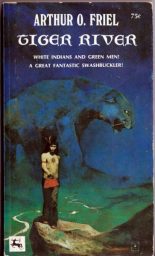 ADVENTURE, this is amazingly good. A sequel to THE PATHLESS TRAIL with the same cast of adventurers, TIGER RIVER would be followed by THE KING OF NO MAN`S LAND and MOUNTAINS OF MYSTERY. All wild South American action, full of soldiers of fortune looking for treasure while being chased by headhunters or staring down jaguars or encountering “white Indians” (they never run across Bomba, though) this is great stuff, more than worthy to sit on the shelf next to Talbot Mundy and H. Rider Haggard.
ADVENTURE, this is amazingly good. A sequel to THE PATHLESS TRAIL with the same cast of adventurers, TIGER RIVER would be followed by THE KING OF NO MAN`S LAND and MOUNTAINS OF MYSTERY. All wild South American action, full of soldiers of fortune looking for treasure while being chased by headhunters or staring down jaguars or encountering “white Indians” (they never run across Bomba, though) this is great stuff, more than worthy to sit on the shelf next to Talbot Mundy and H. Rider Haggard.
Hunting (Westhunt): Probably most of our readers don’t have personal experience with old-fashioned, Pleistocene-style big game hunting. The only place in which it is still possible – not for much longer, at that – is Africa, where the big game had a chance to adapt as mankind gradually became formidable hunters and thus managed to survive until today. Without that experience, it’s hard to realize how remarkable Neanderthals were, how difficult hunting bison and elk with thrusting spears must have been.
Games (RMWC Reviews): 1995’s Flight of the Amazon Queen is a LucasArts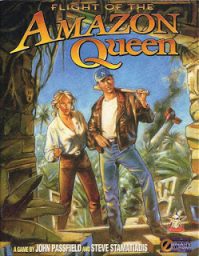 style adventure game released for MS-DOS and the Amiga not made by LucasArts. Instead, this was the product of a small Australian studio called Interactive Binary Illusions. Their previous game was 1993’s well regarded action platformer Halloween Harry (later renamed to Alien Carnage) co-developed with SubZero Software and published by Apogee back in the Duke Nukum (not a typo) 1 & 2 days. Led by by John Passfield and Steve Stamatiadis and released by British publisher Renegade Software, Amazon Queen was Interactive Binary Illusions’ second, and final game.
style adventure game released for MS-DOS and the Amiga not made by LucasArts. Instead, this was the product of a small Australian studio called Interactive Binary Illusions. Their previous game was 1993’s well regarded action platformer Halloween Harry (later renamed to Alien Carnage) co-developed with SubZero Software and published by Apogee back in the Duke Nukum (not a typo) 1 & 2 days. Led by by John Passfield and Steve Stamatiadis and released by British publisher Renegade Software, Amazon Queen was Interactive Binary Illusions’ second, and final game.
U.F.O (Sword and Stitchery): When it comes to pulling off a Sevenies U.F.O.television series \style Chepheus Engine campaign. One of the keys to this is Michael Brown’s Omega 99 campaign setting. Omega 99 offers a moon with some interesting alien neighbors in the form of the Edari, the Kahgg, and the Mecharchs. Some great ideas as well to get the polyester sci fi goodness underway.
U.F.O.television series \style Chepheus Engine campaign. One of the keys to this is Michael Brown’s Omega 99 campaign setting. Omega 99 offers a moon with some interesting alien neighbors in the form of the Edari, the Kahgg, and the Mecharchs. Some great ideas as well to get the polyester sci fi goodness underway.
Lovecraft (Tentaculii): Neal Monks has a new and long review of Robert H. Waugh’s collection A Monster Of Voices: Speaking for H.P. Lovecraft. Initially, he argues, there’s something to be said for Lovecraft as a surrealist, but Waugh observes that his writing style is closer to that of Tolkien. In particular, where [C.S.] Lewis [Narnia books] was very precise in his language, favouring short, clear sentences and convincing arguments, Lovecraft, like Tolkien, always has more to say.
Forthcoming (DMR Books): DMR Books has acquired reprint rights to the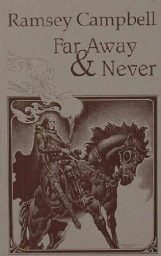 dark swords and sorcery collection Far Away and Never by Ramsey Campbell. The agent was John Jarrold. The collection, originally published 25 years ago by Necronomicon Press, contains all of Campbell’s stories of Ryre which appeared in the Swords Against Darkness anthologies. This edition will also include an extra story – “A Madness From the Vaults.” The book is due for publication in the autumn of 2021.
dark swords and sorcery collection Far Away and Never by Ramsey Campbell. The agent was John Jarrold. The collection, originally published 25 years ago by Necronomicon Press, contains all of Campbell’s stories of Ryre which appeared in the Swords Against Darkness anthologies. This edition will also include an extra story – “A Madness From the Vaults.” The book is due for publication in the autumn of 2021.
Horror (Irish Times): As a life-long connoisseur of horror, I seldom experience genuine “fear” while reading (or viewing) – that adrenaline-fuelled dread termed “art-horror” by Noel Carroll in The Philosophy of Horror. It does happen to me on occasion though, this sense of frisson: I remember the worrying, childhood anxiety of the doomsday clock in John Bellairs’s The House with a Clock in Its Walls, that horrible cosmic grandeur I experienced the first time I turned the pages of William Hope Hodgson’s The House on the Borderland, or the overbearing sense of inexorable supernatural fate in Shirley Jackson’s The Haunting of Hill House.
Fiction (Goodman Games): While all of Wellman’s oeuvre is worth reading, it is his Silver John stories that most impacted the world of fantasy role-playing. Wellman is one of the names on Gygax’s Appendix N roster of influential authors. Although no specific title is listed alongside his name, it’s been suggested that the character of Silver John influenced the bard class in D&D—a wandering troubadour who uses song, magic, and knowledge to defeat supernatural menaces. Stripped of the pseudo-medieval trappings of D&D, the bard and Silver John become almost indistinguishable from one another.
it is his Silver John stories that most impacted the world of fantasy role-playing. Wellman is one of the names on Gygax’s Appendix N roster of influential authors. Although no specific title is listed alongside his name, it’s been suggested that the character of Silver John influenced the bard class in D&D—a wandering troubadour who uses song, magic, and knowledge to defeat supernatural menaces. Stripped of the pseudo-medieval trappings of D&D, the bard and Silver John become almost indistinguishable from one another.
RPG (Walker’s Retreat): The RPG Pundit cut a video yesterday on the latest round of Wizards of the Coast converging D&D as fast as they can.
Fiction (Adventures Fantastic): For today’s post, I’m going to look at “The Story of the Beetle-Hunter”. It’s from the June 1898 issue of The Strand, one of the premiere fiction magazines of the day. It’s also the first of the stories collected in Round the Fire Stories, a series of mysteries published in The Strand after the “death” of Sherlock Holmes.
T.V. (Jon Mollison): The good stuff. Back in the early 1990’s director Joe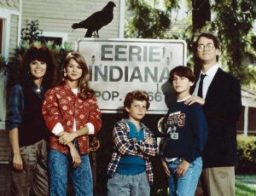 Dante (Matinee, Gremlins) made a little low-budget anthology show called Eerie, Indiana, that deserves a lot more love than it gets. The simple premise is that 14-year old Marshall Teller’s family drags him from New Jersey to a small town in Indiana where he immediately notices strange doin’s are a foot. He seems to be the only one to notice these things but quickly finds an ally in ten year old outcast and noticable ginger, Simon Holmes and ohmygoshIjustgotthatreference.
Dante (Matinee, Gremlins) made a little low-budget anthology show called Eerie, Indiana, that deserves a lot more love than it gets. The simple premise is that 14-year old Marshall Teller’s family drags him from New Jersey to a small town in Indiana where he immediately notices strange doin’s are a foot. He seems to be the only one to notice these things but quickly finds an ally in ten year old outcast and noticable ginger, Simon Holmes and ohmygoshIjustgotthatreference.
Military (Last Stand on Zombie Island): That goes not just for the U.S. Navy but for any fleet. With that in mind, the word from First Sea Lord Admiral Tony Radakin this week that the first five names for the future Type 31 frigates for the Royal Navy are familiar. Each name has been selected to represent key themes and operations which will dominate and shape the global mission of the Royal Navy and Royal Marines: carrier operations (Formidable); operational advantage in the North Atlantic (Bulldog); forward deployment of ships around the globe to protect UK interests (Active); technology and innovation (Venturer); and the Future Commando Force (Campbeltown).
Edgar Rice Burroughs (Tellers of Weird Tales): Gentleman John Carter journeyed to Mars, there to fight and befriend Tharks, all before Tarzan swung on his vine. Like James Fenimore Cooper (1789-1851) a century before him, Edgar Rice Burroughs (1875-1950) got his start by believing that he could pen something better than what he was reading in the popular press. He set out in 1911 to write his story. The first place his imagination went was not to the jungles of Africa but to the red planet Mars. John Carter was projected bodily from a mystical Arizona cave. Burroughs made the journey in his mind.
Science Fiction (Fantasy Literature): Ever since reading the truly beautiful and unforgettable fantasy When the Birds Fly South (1945) around 3 ½ years back, I have wanted to experience another book from the San Francisco-born novelist and poet Stanton A. Coblentz. Unfortunately, just as “Coblentz” is not exactly a household name these days, his books are hardly to be found at your local modern-day bookstores. Coming to my rescue once again, however, were the fine folks at Armchair Fiction, who currently have no fewer than five of the author’s titles in their very impressive catalog. Choosing at random, I opted for Coblentz’s very first piece of fiction, The Sunken World … and a very fortuitous choice it has turned out to be!
years back, I have wanted to experience another book from the San Francisco-born novelist and poet Stanton A. Coblentz. Unfortunately, just as “Coblentz” is not exactly a household name these days, his books are hardly to be found at your local modern-day bookstores. Coming to my rescue once again, however, were the fine folks at Armchair Fiction, who currently have no fewer than five of the author’s titles in their very impressive catalog. Choosing at random, I opted for Coblentz’s very first piece of fiction, The Sunken World … and a very fortuitous choice it has turned out to be!
Mars (Hindustan Times): Mars, as seen from Earth: The red planet in pop culture. We’ve recently harnessed oxygen from its atmosphere and managed a flight on it. But the red planet holds sway over our imaginations in wild and wonderful ways too. Check out how Earthlings’ ideas of Mars have changed over time.
Wow. Really, WHO could’ve predicted that bringing Stephanie Phillips on as a writer for Taarna would spell disaster? Who, I ask?
Great post from Lizzi on Westerns and SFF.
Good essay on horror from the IRSH TIMES.
I laughed out loud several times reading that story about Henry Harpending hunting a marauding Cape buffalo. Cape buffs aren’t domestic cows…and even cattle are plenty hard to kill.